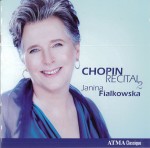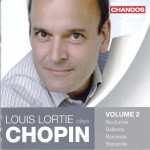
 Chopin Recital 2
Chopin Recital 2
Janina Fialkowska
ATMA ACD2 2666
Chopin – Volume 2
Louis Lortie
Chandos CHAN 10714
Two artists, each presenting a second instalment in their Chopin discography, invite us to ponder their muse through the music of Chopin.
While both Louis Lortie and Janina Fialkowska record on Steinway pianos, their sound is remarkably different. The Lortie/Chandos recording is dark, more heavily pedaled and given more room. Whether this darker tone is the result of instrument voicing or recording equalization is unclear. But the contrast to Fialkowska’s brighter, more present sound lays the groundwork for appreciating the difference between these two pianists.
Fialkowska is quick, articulate and generous with interpretive variations in her tempi. The impression her playing gives is of an artist revelling in the energy of Chopin’s pianistic dance forms. Her command of this composer’s language leaves no doubt about her convictions to follow Chopin through the turmoil of cascading note clusters and the depths of melancholic harmonies. Her playing gives the impression that she feels quite “in-charge” of this material but never surrenders herself entirely to the seduction of Chopin’s voice. Still, she performs very much from “inside” the music.
Lortie is no less an interpreter or technician. He is adept at fluidity of phrasing and coaxing Chopin’s menacing growls to emerge from the piano’s bass register. He favours a more weighty approach that blends keyboard articulation into longer ideas. Somehow, Lortie introduces a stronger element of mystery into this same music. We recognize the composer and his language but see him in less definite terms, with more unanswered questions.
The two recordings present different repertoire with Fialkowska playing waltzes, polonaises and mazurkas, along with the larger F Minor Fantaisie and the B-Flat Minor Scherzo. Lortie, by contrast, gives us nocturnes, ballades, the Berceuse and Barcarolle. Both, however, perform the Ballade No.2 in F Major Op.38 and here we find ground for a revealing comparison.
What appears to distinguish these two extraordinary artists is the extent to which they pull back the curtain to reveal Chopin. The opening ideas of the ballade are short and tender, supported by simple but artful harmonies that return as a coda to close the work. Between them lies a bombastic and turbulent middle section that demands breathtaking technique.
Fialkowska is ready to expose both the explosive and the deeply intimate by pushing the piano to its technical limits from massive volume to notes that are barely played. It’s an all-or-nothing approach with immediate impact. Lortie, by contrast, keeps back from the brink and doesn’t take us all the way to where we know the emotional journey must surely go. This distance of untraveled emotion may be the key to the mystique in Lortie’s art — the power of unfulfilled expectation.
Both these artists command complete attention. Their interpretations are mature and eminently credible. Which of these a listener favours may depend merely upon the mood of the moment. Any serious Chopin collector should own both of these recordings.



